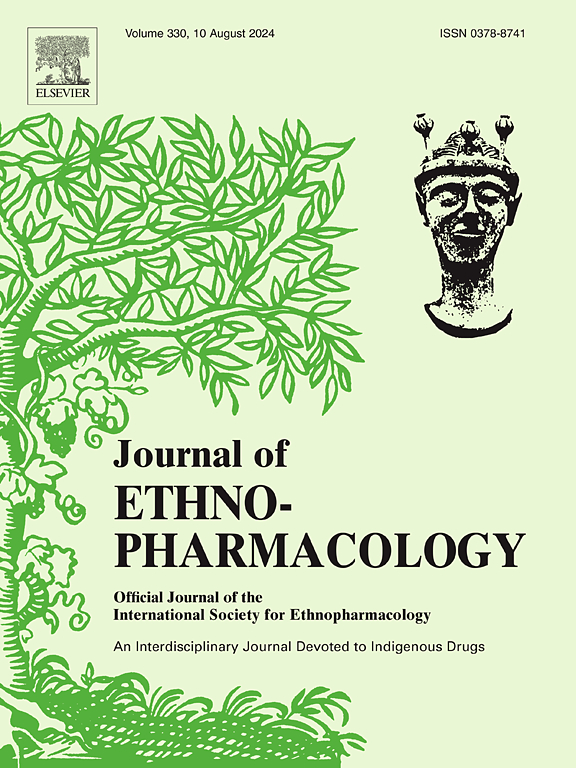Comprehensive characterisation of bioactive compounds in Boletus edulis as functional foods to improve muscle atrophy; through whole plant targeted metabolomics, network pharmacology, in vivo and in vitro experiments, molecular docking and molecular dynamics analysis
IF 4.8
2区 医学
Q1 CHEMISTRY, MEDICINAL
引用次数: 0
Abstract
Ethnopharmacological significance
Boletus edulis (BE) is a naturally occurring fungus that has been traditionally used in ancient Chinese herbal medicine. It is a key component of the formula ‘Shujin Pill’, commonly prescribed for the treatment or relief of muscular dystrophy. However, the specific efficacy of BE within Shujin Pill or its primary active components remains unclear.
Aims of the study
This study aims to elucidate the biological function and molecular mechanisms of BE in alleviating muscular atrophy in mice. We employed a comprehensive approach, integrating metabolomics, network pharmacological analysis, molecular docking, molecular dynamics simulation, and in vivo and in vitro experimental validation, to verify these effects.
Materials and methods
The bioactive components in BE were quantified by UPLC-QTOF-MS/MS. To evaluate the muscle function indexes after 14 days of action of different doses of BE and to analyze the pathological changes in muscle tissue. Enabling network pharmacology to analyze the potential active components in BE for the alleviation of muscle atrophy, using computer molecular simulation for docking scores, molecular dynamics simulation to assist in the validation of the active components in BE, and in vitro experiments for the validation of the active components.
Result
BE administered alone was able to slow down Lipopolysaccharide (LPS)-induced muscle atrophy. 996 non-volatile components were detected in BE by metabolomics, and GAPDH, TP53, AKT1, TNF-α and IL-6 were more strongly associated with muscle atrophy by using web-based pharmacological analyses. Folic acid, Cycloartenol and Sesamin active ingredients have greater potential to treat or alleviate muscle atrophy, molecular docking, molecular dynamics detected that Sesamin and AKT both have high binding energy, in vitro using C2C12 skeletal muscle cells to verify the efficacy of Sesamin and BE, found that in the presence of the LY294002 (PI3K inhibitor) and GSK21417 (AKT inhibitor) treatment conditions, the elimination of the up-regulation of the PI3K/AKT signaling pathway by Sesamin and BE and loss of biological efficacy. It suggests that BE may slow down or treat muscle atrophy through the PI3K/AKT signaling pathway, in which Sesamin plays a major role. Meanwhile BE and Sesamin were able to enhance the antioxidant level of C2C12 skeletal muscle cells.

求助全文
约1分钟内获得全文
求助全文
来源期刊

Journal of ethnopharmacology
医学-全科医学与补充医学
CiteScore
10.30
自引率
5.60%
发文量
967
审稿时长
77 days
期刊介绍:
The Journal of Ethnopharmacology is dedicated to the exchange of information and understandings about people''s use of plants, fungi, animals, microorganisms and minerals and their biological and pharmacological effects based on the principles established through international conventions. Early people confronted with illness and disease, discovered a wealth of useful therapeutic agents in the plant and animal kingdoms. The empirical knowledge of these medicinal substances and their toxic potential was passed on by oral tradition and sometimes recorded in herbals and other texts on materia medica. Many valuable drugs of today (e.g., atropine, ephedrine, tubocurarine, digoxin, reserpine) came into use through the study of indigenous remedies. Chemists continue to use plant-derived drugs (e.g., morphine, taxol, physostigmine, quinidine, emetine) as prototypes in their attempts to develop more effective and less toxic medicinals.
 求助内容:
求助内容: 应助结果提醒方式:
应助结果提醒方式:


